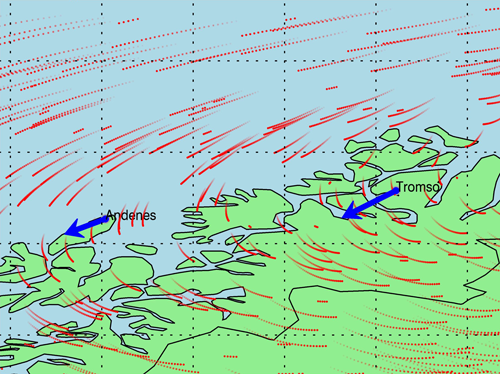Source: Radio Science
The mesosphere is one of the most mysterious layers of our planet’s atmosphere. Hovering between 50 and 85 kilometers above Earth, it is too high for aircraft to reach and too low for satellites to orbit in. To study its cold, thin air, scientists usually launch sounding rockets that take a sample, then fall back to Earth. Now, however, researchers have achieved the first on-the-ground measurement of mesospheric wind fields, using radar that detects falling meteor trails.
Most meteors burn up when they hit the mesosphere, creating the streaks of light we call shooting stars. They also leave a trail of vaporized atoms and free electrons that move with the wind. To learn more about mesospheric wind field patterns, Chau et al. used a new approach, combining a technology called specular meteor radar—which bounces high-frequency waves off the comet trails—with a tomographic approach.

Scientists have been using specular meteor radar to study movements in the mesosphere for more than a decade but without identifying the small-scale variations within the relatively large volume of air. The new study combines 12 years of data from two radar instruments, the Andenes and Tromsø radars in northern Norway. Located 130 kilometers apart, the combined radar data encompass a region roughly 400 kilometers across and 20 kilometers in altitude.
The data revealed a previously undetected pattern. During summer, the large, swirling vortices that form in the mesosphere reversed their clockwise direction at an altitude of roughly 86 kilometers above Earth and started rotating counterclockwise instead. The researchers also saw that these vortices are accompanied by pattern changes in the horizontal divergence—the extent to which air draws together or converges—and started spreading out around that altitude. The results suggest a fresh approach to measuring large-scale phenomena in this little-studied layer of the atmosphere. (Radio Science, https://doi.org/10.1002/2016RS006225, 2017)
—Emily Underwood, Freelance Writer
Citation:
Underwood, E. (2017), Tracking meteor trails to study the mesosphere, Eos, 98, https://doi.org/10.1029/2017EO079237. Published on 09 August 2017.
Text © 2017. The authors. CC BY-NC-ND 3.0
Except where otherwise noted, images are subject to copyright. Any reuse without express permission from the copyright owner is prohibited.

